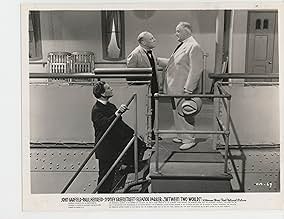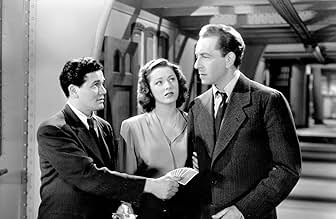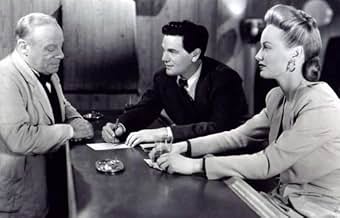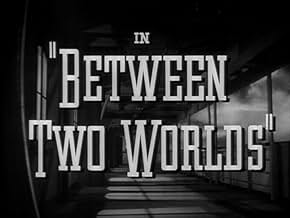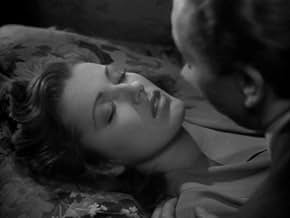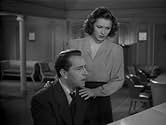IMDb RATING
7.1/10
2.6K
YOUR RATING
Passengers on an ocean liner can't recall how they got on board or where they are going yet, oddly enough, it soon becomes apparent that they all have something in common.Passengers on an ocean liner can't recall how they got on board or where they are going yet, oddly enough, it soon becomes apparent that they all have something in common.Passengers on an ocean liner can't recall how they got on board or where they are going yet, oddly enough, it soon becomes apparent that they all have something in common.
- Director
- Writers
- Stars
- Awards
- 4 wins total
Sami Ayanoglu
- Davis
- (uncredited)
Lester Matthews
- Steamship Dispatcher
- (uncredited)
Patrick O'Moore
- Steamship Clerk
- (uncredited)
- Director
- Writers
- All cast & crew
- Production, box office & more at IMDbPro
Featured reviews
Between Two Worlds was a 1944 remake of the 1930 Leslie Howard film, Outward Bound, which was a hit on Broadway. This allegorical tale about death was the perfect World War II film and boasted a super ensemble cast--each and every cast member is wonderful. The stars, John Garfield, Paul Henreid, Eleanor Parker, and Sydney Greenstreet, give top-notch performances, but the film also boasts high points in the careers of Isobel Elsom, Faye Emerson, Dennis King, Sara Allgood, Gilbert Emery, and Edmund Gwenn. Each actor gets a share of the spotlight as they slowly discover their fate and face the final judgment. Nicely directed with a good set, although the music picks up bits from Casablanca. Moody and yes maybe talky by today's standards, but very effective and moving. My favorite is haughty Isobel Elsom, the great British actress who came to Hollywood in the mid 30s, after being one of England's biggest silent-film stars. She has the role Alison Skipworth played in the 1930 version, but her imperious demeanor takes on a whole new meaning in 1944, set against the war. This is the kind of film that can't be made any more, and when film-makers try, their efforts sink from view very quickly. Powerful and touching film filled with great moments. This one is a must see.
I haven't seen this movie for decades, but I still remember it well. It has a haunting 'twilight zone' twist to it and is very entertaining. I'm surprised, in this in this 'post Titanic megahit' time, that an ocean liner backdrop to an eerie, romantic story has not been recycled as was 'Death Takes a Holiday'. It might even be re-incarnated as a 'Fantasy Island' type TV series with new passengers every week.
You expect justice and good to win out in movies of this era. It's nice they left enough 'wiggle' room to do the right thing. And I think people take a comfort from a good movie showing us going on after death. It's a trip we all hope to take one day....
You expect justice and good to win out in movies of this era. It's nice they left enough 'wiggle' room to do the right thing. And I think people take a comfort from a good movie showing us going on after death. It's a trip we all hope to take one day....
It's been years since I saw this on television, but it's one of the films I remember best. The plot deals with the most common cultural and spiritual views of the afterlife in a fascinating, allegorical way; it also deals with moral concerns about the way people live their lives. John Garfield is great, as usual. Some of the most wonderful, familiar character actors of old Hollywood bring much heart and integrity to well-defined roles.
"Between Two Worlds" is one of the best examples of one of the rarest of move genres, a fantasy for grown-ups. I can't think of many other successful examples of this sort of thing off hand beyond, perhaps, Powell and Pressburger's "A Matter of Life and Death".
By "adult" I do not, of course, mean that there is anything off-color or X-rated about the film. On the contrary, it's pretty tame by today's standards. This film is simply a fantasy for adults in the sense that it was not for or about children or adolescents.
A small, ill-assorted group of people find themselves together at night on a fog-shrouded passenger ship with no other passengers, and no crew save for a single steward. Two of the passengers, who are slightly apart from the others, have committed suicide and are aware that they are dead. The others know nothing. The steward, who knows what is going on, caters to the passengers wishes and pretends that everything is normal.
The film is very well done, with a first-rate cast of the sort of character actors they simply can't assemble anymore, wonderfully atmospheric sets, and set against an excellent Korngold musical score. I understand there was an earlier version with Leslie Howard, called "Outward Bound". I've never seen it, but it would be interesting to see it and compare it with this version.
By "adult" I do not, of course, mean that there is anything off-color or X-rated about the film. On the contrary, it's pretty tame by today's standards. This film is simply a fantasy for adults in the sense that it was not for or about children or adolescents.
A small, ill-assorted group of people find themselves together at night on a fog-shrouded passenger ship with no other passengers, and no crew save for a single steward. Two of the passengers, who are slightly apart from the others, have committed suicide and are aware that they are dead. The others know nothing. The steward, who knows what is going on, caters to the passengers wishes and pretends that everything is normal.
The film is very well done, with a first-rate cast of the sort of character actors they simply can't assemble anymore, wonderfully atmospheric sets, and set against an excellent Korngold musical score. I understand there was an earlier version with Leslie Howard, called "Outward Bound". I've never seen it, but it would be interesting to see it and compare it with this version.
This is a remake of the 1930 early-talkie "Outward Bound", which was based on the hit 1925 stage play. This version updates the period from the 1920's to the 1940's, and incorporates WW II elements into the story---a totally unnecessary tactic; the original play was quite good on its own and didn't need to have topical elements awkwardly sandwiched in. In fact,one of its strengths was that the entire unworldly experience seemed to take place in an unspecified time.
But this film has a very realistic beginning to it, and a war-related incident sets the plot in motion. The film's only serious blunder---though one that does not fatally affect it----is that we are tipped off as to what is really going on much too early in the film, in comparison to the 1930 film version, in which the characters realized their true situation at the same time as the audience did.
Aside from those objections, though, this is one of the few remakes which tops the original in nearly every department. Without exception, the actors in this version outdo the stiff, primitive early-talkie performances of their predecessors, and this may well be the only film in which Paul Henreid, normally not the most charismatic actor, gives a finer performance than the then-awkward Douglas Fairbanks,Jr. did in the same role in the 1930 film.
Especially outstanding are Edmund Gwenn as the ship's steward, Isobel Elsom as a rich, elderly, bitchy woman, Sydney Greenstreet as a mysterious character whose identity will not be revealed here, and Sara Allgood in one of the most sensitive performances of her career (she acts rings around Beryl Mercer from the 1930 version). George Coulouris, a reliable villain in those days (he was Orson Welles' nasty guardian in "Citizen Kane") is sinister and pompous as a greedy tycoon. And John Garfield is excellent in the Leslie Howard role, altered some to fit Garfield's tough, bitter on-screen persona rather than Howard's ultra-sophisticated, debonair one. (Garfield,though,does not go as berserk when he finds out the truth as Howard so hilariously did in the 1930 version.)
Although much of the dialogue in the first half has been changed and perhaps made slightly less "literary", the second half,which features Sydney Greensteet, is quite faithful to the earlier film and the stage play. Erich Wolfgang Korngold's music runs through nearly every scene, and, although verging toward the bombastic and melodramatic at times, lends plenty of atmosphere to the story.
One unfortunate aspect is that the photography in this version never becomes as eerie as that in the 1930 version, with its striking light and darkness effects. But none of these faults should keep you away from this film, which deserves far better than its relative obscurity in comparison to the other great Warner Bros. classics as well as other films dealing with the afterlife.
But this film has a very realistic beginning to it, and a war-related incident sets the plot in motion. The film's only serious blunder---though one that does not fatally affect it----is that we are tipped off as to what is really going on much too early in the film, in comparison to the 1930 film version, in which the characters realized their true situation at the same time as the audience did.
Aside from those objections, though, this is one of the few remakes which tops the original in nearly every department. Without exception, the actors in this version outdo the stiff, primitive early-talkie performances of their predecessors, and this may well be the only film in which Paul Henreid, normally not the most charismatic actor, gives a finer performance than the then-awkward Douglas Fairbanks,Jr. did in the same role in the 1930 film.
Especially outstanding are Edmund Gwenn as the ship's steward, Isobel Elsom as a rich, elderly, bitchy woman, Sydney Greenstreet as a mysterious character whose identity will not be revealed here, and Sara Allgood in one of the most sensitive performances of her career (she acts rings around Beryl Mercer from the 1930 version). George Coulouris, a reliable villain in those days (he was Orson Welles' nasty guardian in "Citizen Kane") is sinister and pompous as a greedy tycoon. And John Garfield is excellent in the Leslie Howard role, altered some to fit Garfield's tough, bitter on-screen persona rather than Howard's ultra-sophisticated, debonair one. (Garfield,though,does not go as berserk when he finds out the truth as Howard so hilariously did in the 1930 version.)
Although much of the dialogue in the first half has been changed and perhaps made slightly less "literary", the second half,which features Sydney Greensteet, is quite faithful to the earlier film and the stage play. Erich Wolfgang Korngold's music runs through nearly every scene, and, although verging toward the bombastic and melodramatic at times, lends plenty of atmosphere to the story.
One unfortunate aspect is that the photography in this version never becomes as eerie as that in the 1930 version, with its striking light and darkness effects. But none of these faults should keep you away from this film, which deserves far better than its relative obscurity in comparison to the other great Warner Bros. classics as well as other films dealing with the afterlife.
Did you know
- TriviaComposer Erich Wolfgang Korngold named this film as his personal favorite among his film scores.
- GoofsWhen the Bergners first arrive aboard the ship, the shadow of a klieg light can be seen on one of the double doors as they pass through.
- Alternate versionsTwo versions of the movie exist. The latest, published by Warner Archive in Sept. 2006, is the 112 minute cut. Another version of 121 minutes, including a rarely seen cut scene between Ann and Tom and a few additional shots of the casino parts, has been broadcast by a few TV networks in the 2000s in Europe and East Asia.
- ConnectionsFeatured in Between Two Worlds: Erich Wolfgang Korngold (2005)
Details
- Runtime1 hour 52 minutes
- Color
- Aspect ratio
- 1.37 : 1
Contribute to this page
Suggest an edit or add missing content


